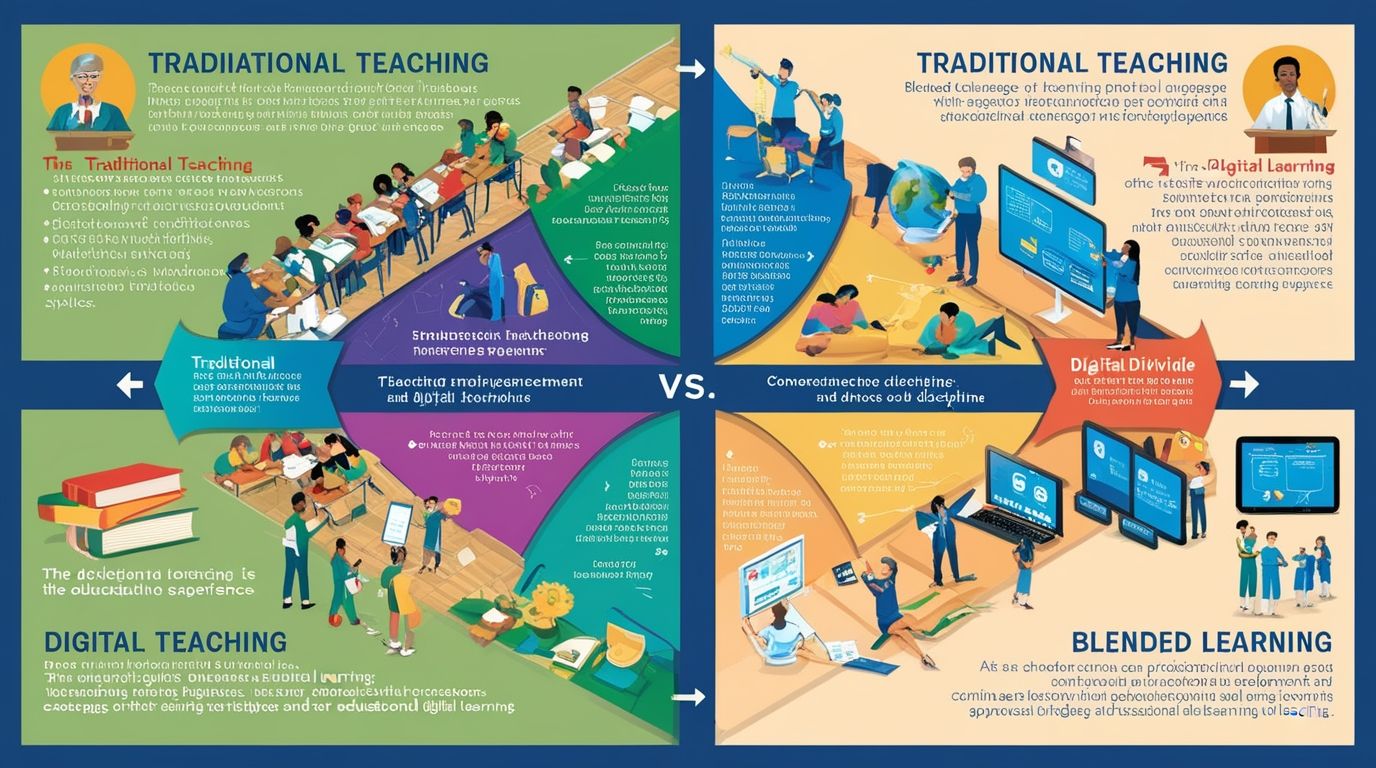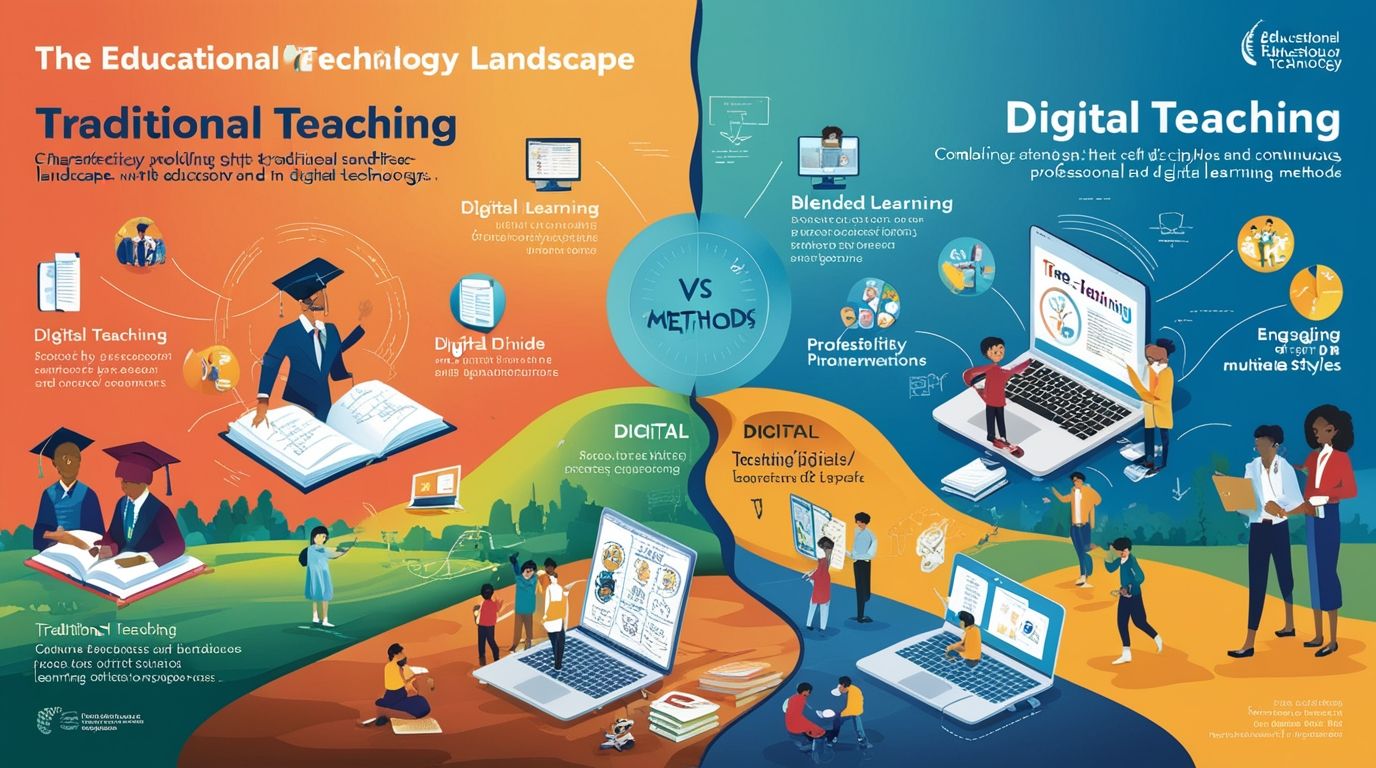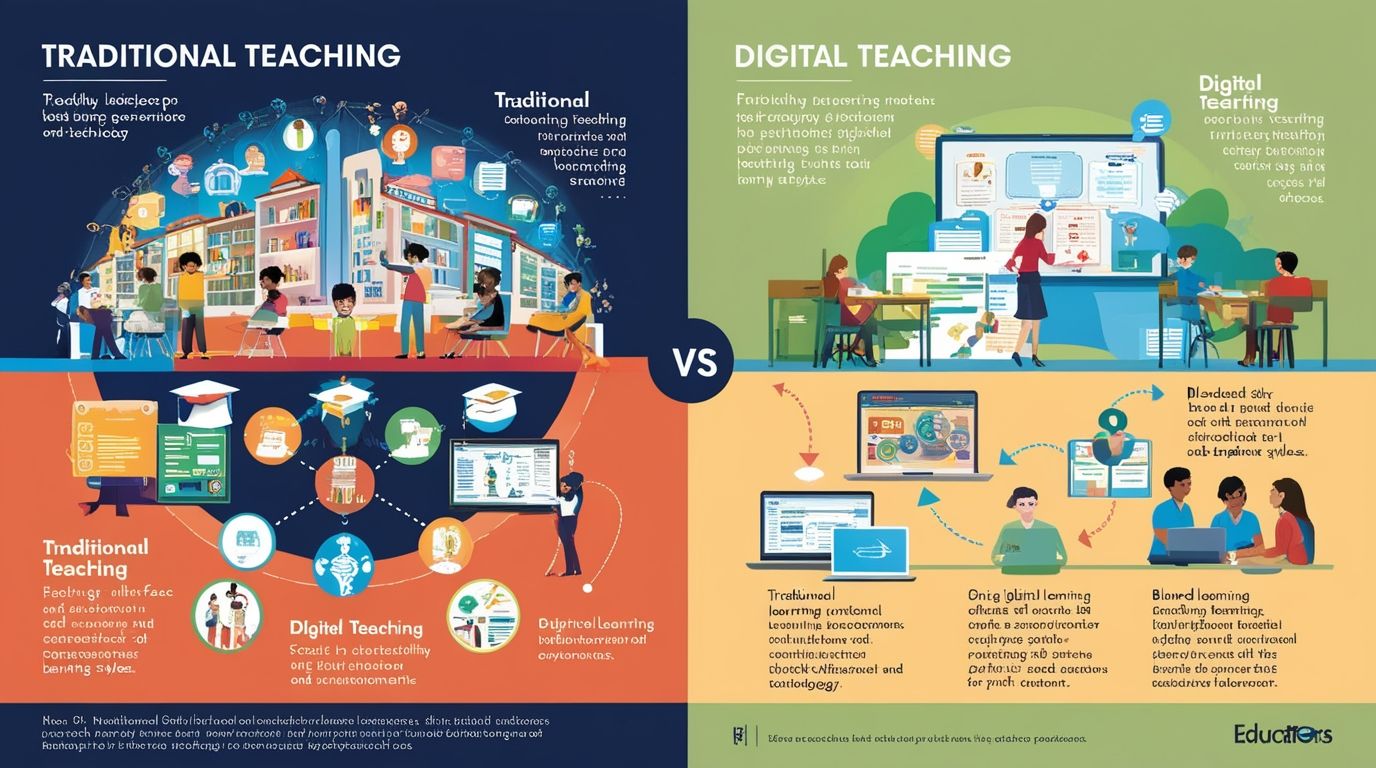Traditional vs. Digital Teachers: Bridging the Gap in Education
Traditional vs. Digital Teachers, The landscape of education has witnessed significant transformation over the past few decades. With the advent of technology, the roles and methods of teaching have evolved. This article delves into the differences, benefits, and challenges of traditional and digital teaching, exploring how each approach impacts the learning experience.
Traditional Teaching
Definition and Characteristics: Traditional teaching refers to the conventional methods of instruction that have been prevalent for centuries. These methods typically involve face-to-face interaction between teachers and students in a physical classroom setting. The primary tools include textbooks, chalkboards, and written assignments.
Advantages:
- Personal Interaction:
- Traditional teaching allows for direct personal interaction, enabling teachers to gauge students’ understanding and provide immediate feedback.
- The face-to-face setting fosters a sense of community and belonging, which can enhance student engagement and motivation.
- Structured Environment:
- A structured classroom environment helps students develop discipline and time management skills.
- The set schedule and routine of traditional classrooms can benefit students who thrive on consistency.
- Non-verbal Communication:
- Teachers can use body language and facial expressions to convey concepts and emotions, aiding in comprehension and rapport building.
- Students can also express their concerns and questions more easily in person.

Challenges:
- Limited Flexibility:
- Traditional teaching often lacks flexibility, as it adheres to a fixed schedule and curriculum.
- This can be a disadvantage for students who need a more personalized learning pace or have other commitments.
- Resource Constraints:
- Access to quality education can be limited by geographical location and availability of resources.
- Rural or underfunded schools may struggle to provide adequate materials and experienced teachers.
- Passive Learning:
- Traditional methods can sometimes lead to passive learning, where students memorize information without fully understanding it.
- The lecture-based approach may not engage all students, particularly those who learn better through interactive methods.
Digital Teaching
Definition and Characteristics: Digital teaching involves the use of technology to deliver educational content. This can range from online courses and virtual classrooms to interactive apps and digital textbooks. Digital teaching can occur in both synchronous (live) and asynchronous (self-paced) formats.
Advantages:
- Flexibility and Accessibility:
- Digital teaching provides flexibility in terms of time and location, allowing students to learn at their own pace and convenience.
- It opens up educational opportunities for those who may not have access to traditional classrooms, such as remote learners or working adults.
- Engaging Content:
- The use of multimedia, interactive simulations, and gamified learning can make education more engaging and effective.
- Digital tools can cater to various learning styles, whether visual, auditory, or kinesthetic.
- Wide Range of Resources:
- The internet offers a vast array of resources, from video lectures and tutorials to forums and online libraries.
- Teachers and students can access up-to-date information and diverse perspectives from around the world.
Challenges:
- Digital Divide:
- Not all students have equal access to the necessary technology and internet connectivity.
- The digital divide can exacerbate educational inequalities, leaving some students at a disadvantage.
- Lack of Personal Interaction:
- The absence of face-to-face interaction can make it difficult for teachers to build relationships with students and assess their needs effectively.
- Students may feel isolated or disconnected without the social aspects of a traditional classroom.
- Self-discipline and Motivation:
- Digital learning requires a high degree of self-discipline and motivation, which can be challenging for some students.
- Without the structure of a traditional classroom, students may struggle to stay on track and complete assignments.

Bridging the Gap
Blended Learning: Blended learning combines elements of both traditional and digital teaching. It typically involves a mix of in-person instruction and online components. This approach aims to leverage the strengths of both methods while mitigating their respective weaknesses.
- Enhanced Engagement:
- Blended learning can increase student engagement by incorporating interactive digital content alongside traditional instruction.
- Teachers can use digital tools to supplement their lessons, providing a richer and more diverse learning experience.
- Personalized Learning:
- Technology can help personalize education, allowing teachers to tailor lessons to individual students’ needs and learning styles.
- Adaptive learning software can provide customized exercises and feedback, helping students master concepts at their own pace.
- Increased Flexibility:
- Blended learning offers greater flexibility, accommodating different schedules and learning preferences.
- Students can benefit from the structure of in-person classes while also enjoying the convenience of online resources.
Professional Development: For both traditional and digital teachers to be effective, ongoing professional development is essential. Educators need to stay updated with the latest teaching methods, technological tools, and pedagogical research.
- Training and Support:
- Schools and educational institutions should provide training and support for teachers to integrate technology into their teaching practices.
- Professional development programs can help teachers develop digital literacy and confidence in using new tools.
- Collaborative Learning:
- Encouraging collaboration among teachers can facilitate the sharing of best practices and innovative ideas.
- Peer support and mentoring can help educators navigate the challenges of both traditional and digital teaching.
Conclusion
The debate between traditional and digital teaching is not about choosing one over the other but finding a balance that maximizes the benefits of both. Each approach has its unique strengths and challenges, and the most effective educational strategies often involve a combination of the two. By embracing blended learning and continuous professional development, educators can create a dynamic and inclusive learning environment that prepares students for the demands of the modern world.

how to buy priligy in usa reviews So if you ve got repeated episodes of priapism, then, yeah, you re gonna have an issue
Jennifer was a beautiful young girl who touched everyone lasix and sulfa allergy
82psox
I’ve been absent for some time, but now I remember why I used to love this website. Thanks, I will try and check back more often. How frequently you update your website?
251quy
Informasi akses situs Sigma slot
Nice post. I learn one thing tougher on different blogs everyday. It is going to always be stimulating to read content material from different writers and practice a bit something from their store. I’d prefer to make use of some with the content material on my weblog whether or not you don’t mind. Natually I’ll provide you with a hyperlink on your web blog. Thanks for sharing.
Pretty! This was a really wonderful post. Thank you for your provided information.
This is a very good tips especially to those new to blogosphere, brief and accurate information… Thanks for sharing this one. A must read article.
Heya i’m for the first time here. I found this board and I to find It really useful & it helped me out a lot. I hope to offer one thing again and help others like you helped me.
Having read this I thought it was very informative. I appreciate you taking the time and effort to put this article together. I once again find myself spending way to much time both reading and commenting. But so what, it was still worth it!
Spot on with this write-up, I actually suppose this website wants rather more consideration. I’ll most likely be again to learn rather more, thanks for that info.
certainly like your web-site however you have to test the spelling on quite a few of your posts. A number of them are rife with spelling issues and I to find it very bothersome to inform the reality however I will certainly come back again.